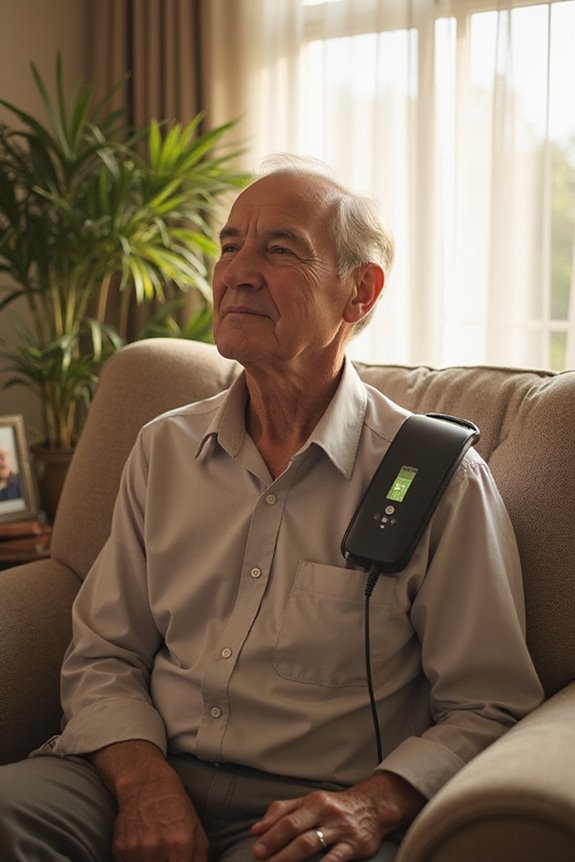Pain management for arthritis sufferers includes pharmacological and non-pharmacological strategies.
Pharmacological Options:
- NSAIDs: Ibuprofen and naproxen for anti-inflammatory effects.
- Acetaminophen: Safer alternative, less effective than NSAIDs.
- Opioids: Tramadol for severe cases; opioids are limited to intense pain.
Non-Pharmacological Strategies:
- Mindfulness and CBT for mental relief.
- Exercise, including range-of-motion and aerobic types, enhances joint health.
Understanding these methods is essential for effective pain management. Further information is available on particular strategies and their benefits.
Key Takeaways
- Utilize NSAIDs like ibuprofen and naproxen for effective pain relief, while monitoring for potential gastrointestinal and cardiovascular risks.
- Incorporate non-pharmacological strategies such as mindfulness, cognitive-behavioral therapy, and community support to manage emotional well-being and pain.
- Engage in regular exercise, including range-of-motion, strengthening, and aerobic activities, to enhance joint mobility and overall health.
- Recognize and manage pain flare-ups by identifying triggers, adhering to treatment plans, and making necessary lifestyle adjustments.
- Ensure patient education on treatment risks, safe medication use, and self-management techniques to promote effective pain management.
Pharmacological Options for Pain Relief
Pharmacological options for pain relief in arthritis are diverse, catering to the specific needs of patients suffering from osteoarthritis (OA) and rheumatoid arthritis (RA).
Nonsteroidal Anti-Inflammatory Drugs (NSAIDs)
- Ibuprofen and naproxen are common NSAIDs for OA pain relief.
- Diclofenac is another effective oral NSAID.
Acetaminophen
– Often recommended for safety but less effective than NSAIDs.
Opioid Alternatives
- Tramadol can be used when NSAIDs or acetaminophen are ineffective.
- Opioids are reserved for severe OA pain due to side effects.
Corticosteroids
– Intra-articular corticosteroids are effective for RA joint flares.
Combination Therapies
– Fixed-dose combinations, like tramadol/paracetamol, offer multi-faceted pain management.
Understanding these options is essential for effective pain management in arthritis patients. Additionally, incorporating TENS units can provide a non-pharmacological approach to alleviate pain.
Non-Pharmacological Strategies for Arthritis Pain

Non-pharmacological strategies for arthritis pain management play an essential role in complementing medical treatments. These approaches include:
- Mindfulness Techniques: Practices such as meditation promote relaxation, which can lead to reduced pain perception.
- Cognitive-Behavioral Therapy (CBT): This psychological approach alters thought processes and behaviors to manage pain effectively.
- Digital Therapeutics: Emerging technologies, including mobile applications and virtual reality, provide innovative pathways for pain management.
In addition, lifestyle adjustments like proper footwear, adequate sleep, and dietary modifications contribute appreciably to overall pain relief. Supportive community groups also enhance emotional well-being, fostering a sense of belonging among arthritis sufferers. Together, these strategies create a thorough framework for managing arthritis pain.
The Role of Exercise in Pain Management

Exercise plays a pivotal role in the management of arthritis pain, complementing various non-pharmacological strategies. Engaging in physical activity offers numerous exercise benefits that enhance joint mobility and overall health.
Types of Exercise:
- Range-of-motion exercises maintain joint flexibility and reduce stiffness.
- Strengthening exercises build muscle support around joints, alleviating pain.
- Aerobic exercises like walking and swimming improve cardiovascular health with minimal joint strain.
Benefits of Exercise:
- Stimulates synovial fluid production, enhancing joint lubrication.
- Facilitates nutrient circulation, improving joint health.
- Reduces pain and stiffness through regular movement.
Long-term Effects:
- Sustained pain management and improved quality of life.
- Supports weight management, reducing stress on joints.
- Incorporating ergonomic design features into your exercise routine can further enhance comfort and reduce strain during physical activities.
Consistent exercise fosters a supportive community, encouraging shared experiences among arthritis sufferers.
Understanding Pain Flare-Ups and Chronic Pain

How can individuals with arthritis better understand the complexities of pain flare-ups and chronic pain? Recognizing the nature of flare-ups is vital. These are sudden increases in symptoms such as pain, stiffness, and swelling, often triggered by factors like overexertion, stress, or changes in weather.
Chronic pain, on the other hand, results from ongoing joint damage and can persist even during remission. Pain differentiation is essential; acute flare-ups are characterized by intense, short-term symptoms, while chronic pain is a continuous burden.
Understanding flare-up triggers, such as infections or poor sleep, allows for proactive management. Effective strategies include early recognition of flare-ups, adherence to prescribed medications, and lifestyle adjustments tailored to individual needs. Additionally, incorporating heat therapy options can provide significant relief during flare-ups.
Safety Considerations in Arthritis Pain Management

Effective management requires awareness of potential drug interactions and patient monitoring. Key considerations include:
- NSAIDs: While effective, they pose risks such as gastrointestinal and cardiovascular issues, particularly at high doses.
- Paracetamol: It can cause liver toxicity, especially when combined with other products.
- Duloxetine and Tramadol: These alternatives need careful monitoring due to side effects.
- Non-Pharmacological Approaches: Low-impact exercises and tai chi can enhance safety and reduce joint stress.
- Patient Education: Informing patients about treatment risks and self-management techniques is vital. Additionally, incorporating non-drug, non-invasive pain relief options can provide significant benefits for arthritis sufferers.
Frequently Asked Questions
How Can Diet Affect Arthritis Pain and Inflammation?
Ironically, while many chase quick fixes, embracing anti-inflammatory foods improves gut health and reduces arthritis pain. A diverse diet fosters community, transforming shared meals into healing experiences, effortlessly bridging the gap between nourishment and comfort.
Are There Specific Supplements That Help With Arthritis Pain Relief?
Many seek information on supplements for pain relief. Turmeric benefits include anti-inflammatory properties, while omega-3s effectiveness in reducing inflammation is noted. Users often report varying results, highlighting the importance of individual needs and professional guidance.
What Role Does Stress Management Play in Arthritis Pain?
Stress management plays an essential role in alleviating arthritis pain, as stress reduction and relaxation techniques can mitigate inflammation. By incorporating practices like yoga and mindfulness, individuals may experience improved overall well-being and symptom relief.
How Does Weather Impact Arthritis Pain Levels?
In a world reminiscent of ancient lore, modern understanding reveals that temperature changes and humidity levels greatly influence pain. Individuals often experience increased discomfort during colder, damp conditions, highlighting the intricate relationship between weather and physical sensations.
What Are the Benefits of Support Groups for Arthritis Sufferers?
Support groups offer peer support, fostering emotional healing and a sense of belonging. Individuals connect through shared experiences, gaining practical coping strategies and encouragement, ultimately enhancing their overall well-being and quality of life in challenging circumstances.





